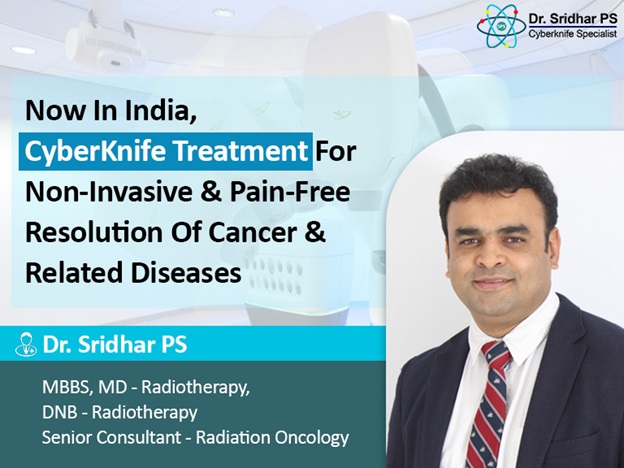Now in India CyberKnife treatment for non-invasive and pain-free resolution of cancer & related diseases
Published on September 28, 2022
CyberKnife is an advanced radiation therapy platform that delivers targeted radiation to destroy tumors in less time. It is a non-invasive procedure that works with precision and better delivery rate. CyberKnife treatment has emerged as much preferred radiation therapy worldwide.

In medical terms, CyberKnife is a recent frameless stereotactic radiosurgery system which uses advance robotics with computerized image reconstruction to enable a highly conformal image guided radiation delivery.
Dr. Sridhar P S is a leading Cyberknife Specialist in India with nearly 19+ years of professional practice. He is an expert in IMRT, IGRT, Tomotherapy and SBRT, biotherapy, chemotherapy and other types of targeted therapy. Dr Sridhar P S states, ‘CyberKnife is an emerging treatment that is pain free as it requires no incision or anesthesia, while treating a variety of cancers. Also less than five treatments could be adequate, depending upon the patient’s condition.‘
He further states that CyberKnife is most useful in treating lung cancer especially those in respiratory failure while in liver cancer, it enables the removal of liver metastases without affecting the liver tissue. CyberKnife treatment of pancreatic cancer includes non-surgical removal of pancreatic tumor while in prostate cancer, it is used to remove localized prostate cancer
Stereotactic Radiosurgery (SRS) is a type of CyberKnife treatment to treat tumors and growths of the neck, lung, spine, liver, brain and other body parts using focused radiation beams. It is a non invasive procedure.
Stereotactic Body Radiation Therapy (SBRT) refers to delivery of highly concentrated radiation spread over days to treat patients with small cancers which have not spread to other body parts. Doctors take precaution to limit radiation from reaching and affecting the healthy organs and tissues located nearby.
Both SRS and SBRT are assisted with three-dimensional image guidance to ensure precise delivery of radiation beams to the tumor. These radiation beams damage the DNA of the cancer and make the tumor shrink in size to prevent cell multiplication.
SBRT is preferred in treating tumors that have been previously treated with radiation as its possible to take advantage of real-time tumor tracking and high precision delivery. The other main benefit being the immunomodulatory effect of SBRT that helps in controlling the cancer and works a like a cancer vaccine. Both these options are effective in treating well-defined and small sized tumors that cannot be surgically removed.
Radiologists use a CT Scan or CyberKnife treatment planning computer to take 3D images of the tumor and its location. During this process intravenous implantation of radiographic markers is also done as it helps them to accurately target the tumor during the procedure.
The before-treatment images guide the experts in planning the number of sessions or fractions along with the dosage of radiations. The patient has to just lie down on the couch or bed to receive the targeted radiation beam. A low dose x-ray camera monitors the patients’ movements.
The radiologists compare these images with pre-treatment images to realign the radiation beam for precise delivery. A computer controlled robotic arm delivers the radiation from several angles to the tumor or target area as per their initial planning. The CyberKnife will not cause much damage the healthy tissues and ensure a swift recovery of the patients.
Lastly, it is essential to know about the numerous advantages of CyberKnife Treatment such as careful tracking of the movement of the tumor which occurs due to coughing, swallowing, breathing and feasibility of adjusting the radiation beams. The CyberKnife is accessible to reach areas which cannot be accessed by human beings. The targeted precision in delivery ensures a comprehensive targeting of radiation while minimizing the damage to the nearby areas and organs.
Taking the above points into consideration limited number of sessions is required which are non-invasive and pain free with immediate recovery along with lesser complications post treatment. Prof. Dr. Sridhar Papaiah Susheela is one of the pioneers in Oncology Imaging and has conducted more than 2700 CyberKnife procedures. He has performed radiation treatment for more than 3,000 patients and chemotherapies to critical cancer patients.























